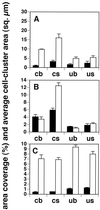Mutualism versus independence: strategies of mixed-species oral biofilms in vitro using saliva as the sole nutrient source
- PMID: 11500457
- PMCID: PMC98697
- DOI: 10.1128/IAI.69.9.5794-5804.2001
Mutualism versus independence: strategies of mixed-species oral biofilms in vitro using saliva as the sole nutrient source
Abstract
During initial dental plaque formation, the ability of a species to grow when others cannot would be advantageous, and enhanced growth through interspecies and intergeneric cooperation could be critical. These characteristics were investigated in three coaggregating early colonizers of the tooth surface (Streptococcus gordonii DL1, Streptococcus oralis 34, and Actinomyces naeslundii T14V). Area coverage and cell cluster size measurements showed that attachment of A. naeslundii and of S. gordonii to glass flowcells was enhanced by a salivary conditioning film, whereas attachment of S. oralis was hindered. Growth experiments using saliva as the sole carbon and nitrogen source showed that A. naeslundii was unable to grow either in planktonic culture or as a biofilm, whereas S. gordonii grew under both conditions. S. oralis grew planktonically, but to a much lower maximum cell density than did S. gordonii; S. oralis did not grow reproducibly as a biofilm. Thus, only S. gordonii possessed all traits advantageous for growth as a solitary and independent resident of the tooth. Two-species biofilm experiments analyzed by laser confocal microscopy showed that neither S. oralis nor A. naeslundii grew when coaggregated pairwise with S. gordonii. However, both S. oralis and A. naeslundii showed luxuriant, interdigitated growth when paired together in coaggregated microcolonies. Thus, the S. oralis-A. naeslundii pair formed a mutualistic relationship, potentially contact dependent, that allows each to grow where neither could survive alone. S. gordonii, in contrast, neither was hindered by nor benefited from the presence of either of the other strains. The formation of mutually beneficial interactions within the developing biofilm may be essential for certain initial colonizers to be retained during early plaque development, whereas other initial colonizers may be unaffected by neighboring cells on the substratum.
Figures






References
-
- Bassler B L. How bacteria talk to each other: regulation of gene expression by quorum sensing. Curr Opin Microbiol. 1999;2:582–587. - PubMed
-
- Bos R, van der Mei H C, Busscher H J. Co-adhesion of oral microbial pairs under flow in the presence of saliva and lactose. J Dent Res. 1996;75:809–815. - PubMed
-
- Byers H L, Tarelli E, Homer K A, Hambley H, Beighton D. Growth of viridans streptococci on human serum alpha1-acid glycoprotein. J Dent Res. 1999;78:1370–1380. - PubMed
MeSH terms
LinkOut - more resources
Full Text Sources

